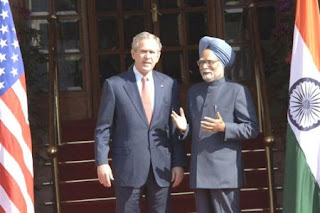
New Delhi (PTI): The Indo-US Nuclear Deal has remained a contentious affair from the word go. The July 18, 2005 Joint Statement by Prime Minister Manmohan Singh and US President George W Bush gave the world the first glimpse of a path-breaking deal that could end India's nuclear isolation.
Singh had hit it off well with the US leader and America was ready for the landmark deal that virtually gives de-facto nuclear weapons state status was the official line. But the Joint Statement itself saw Opposition parties as also the Left parties, then the outside supporters of the Congress-led coalition, raising serious doubts over the deal. In fact, former Prime Minister Atal Behari Vajpayee fired the first salvo raising questions.
The Left parties, which have ideological problems over strategic ties with the US, were also quick to react and questioned the government's decision. The intent to lift the four-decade-old nuclear emabargo and agreeing for the separation of civil and military nuclear facilities in India, set off a flurry of activities both here and in the US to clinch a "landmark" deal for Bush and Singh.
The US had agreed to change its domestic laws which banned supply of any nuclear fuel and technology to India and herald in a "unique" cooperation with New Delhi "not to be replicated to other countries." As officials of the two countries met to take the deal forward, opposition BJP and the Left parties kept up pressure on the government while in the US the Bush administration faced the heat from the non-proliferationists, who were of the the opinion that the agreement would make the NPT regime redundant.
In March, 2006 the Prime Minister announced the Separation Plan for civilian and military atomic reactors, which along with the July 18 joint statement formed the basis of the India-US civilian nuclear cooperation agreement. Government's actions on the foreign policy front, particularly its stand on Iran in the international fora, came up for close scrutiny on the domestic front and when India voted with the US on the issue of clamping sanctions on Tehran.
The Opposition and the Left parties accused the government of surrendering its right to conduct independent foreign policy in order to clinch the deal. India's endorsement of a Non-Aligned Movement (NAM) statement two years ago backing Iran's right to civil nuclear energy subject to its international obligations also drew criticism from the US. In the meantime on November 16, 2006 the US Congress passed the Henry J. Hyde United States-India Peaceful Atomic Energy Cooperation Act of 2006 which granted the US administration a waiver from Section 123 of the Atomic Energy Act to resume nuclear commerce with India.
References to Iran, nuclear testing in the Hyde Act triggered off yet another political storm here with BJP mounting attack on the government for "surrendering" the right to conduct nuclear tests in the future. The Left parties attacked the government for getting closer to "capitalist" US.
The next significant step was the clinching of the 123 Agreement by the US and Indian officials on July 27, 2007. A few weeks later, on August 13 Prime Minister Singh defended the accord and his governement in Parliament saying the country retained the strategic autonomy and sovereign right to conduct a nuclear test.
